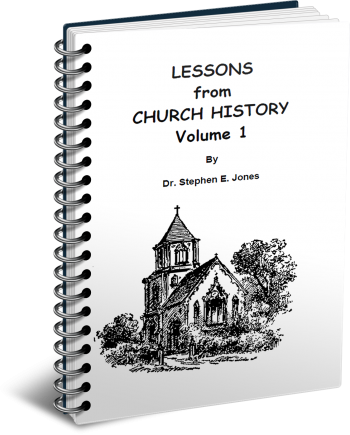Latest Posts
View the latest posts in an easy-to-read list format, with filtering options.

Volume 1. This gives a short history of the Church from the apostles to the Roman War, including Luke’s account of Paul’s journeys in the book of Acts. It includes Paul’s fourth missionary journey to Spain and Britain.
Category - History and Prophecy

While Paul was in Rome (61-63 A.D.) awaiting his first trial under Nero, James was martyred in Jerusalem. Josephus indicates that this took place in the year 62 A.D., the same year that Seneca was forced to retire, and when Burrus, the Prefect of the Guard was murdered.
Recall that while Paul had been under arrest in Jerusalem, Felix had been replaced by Festus in 60. When Festus died in 62, and his successor, Albinus, was still on the way to Judea, the Jewish high priest took advantage of the situation. Speaking of Ananus, the high priest, Josephus, the Jewish historian, says,
“. . . he was also of the sect of the Sadducees, who were very rigid in judging offenders, above all the rest of the Jews, as we have already observed; when, therefore, Ananus was of this disposition, he thought he had now a proper opportunity [to exercise his authority]. Festus was now dead, and Albinus was but upon the road; so he assembled the sanhedrin of the judges, and brought before them the brother of Jesus, who was called Christ, whose name was James, and some others [or some of his companions] and when he had formed an accusation against them as breakers of the law, he delivered them to be stoned.” [Antiquities of the Jews, XX, ix, 1]
Eusebius quotes from Hegesippus a longer account of James' martyrdom, which is of interest to us:
“But the most detailed account of him is given by Hegesippus, who belonged to the first generation after the apostles. In his fifth book he writes:
“ ‘Control of the Church passed to the apostles, together with the Lord's brother James, whom everyone from the Lord's time till our own has called the Righteous [or “The Just”], for there were many Jameses, but this one was holy from his birth; he drank no wine or intoxicating liquor and ate no animal food; no razor came near his head; he did not smear himself with oil, and took no baths [that is, in the public baths]. He alone was permitted to enter the Holy Place, for his garments were not of wool but of linen. He used to enter the Sanctuary alone, and was often found on his knees beseeching forgiveness for the people, so that his knees grew hard like a camel's from his continually bending them in worship of God and beseeching forgiveness for the people’ . . .
“ ‘Representatives of the seven popular sects described by me asked him what was meant by “the door of Jesus,” and he replied that Jesus was the Saviour. Some of them came to believe that Jesus was the Christ; the sects mentioned above did not believe either in a resurrection or in One who is coming to give every man what his deeds deserve, but those who did come to believe did so because of James.
“ ‘Since therefore many even of the ruling class believed, there was an uproar among the Jews, the Scribes, and Pharisees, who said there was a danger that the entire people would expect Jesus as the Christ. So they collected and said to James: “Be good enough to restrain the people, for they have gone astray after Jesus in the belief that he is the Christ. Be good enough to make the facts about Jesus clear to all who come for the Passover Day. We all accept what you say: we can vouch for it, and so can all the people, that you are a righteous man and take no one at his face value. . . . So take your stand on the Temple parapet, so that from that height you may be easily seen, and your words audible to the whole people. For because of the Passover, all the tribes have forgathered, and the Gentiles, too . . .”
“ ‘He [James] replied as loudly as he could: “Why do you question me about the Son of Man? I tell you, He is sitting in heaven at the right hand of the Great Power, and He will come on the clouds of heaven.” Many were convinced and glorified in James' testimony, crying: Hosanna to the Son of David! Then again the Scribes and Pharisees said to each other, “We had better go up and throw him down, so that they will be frightened and not believe him. Ho! Ho! they called out, even the Righteous one has gone astray! . . .”
“ ‘So they went up and threw down the Righteous one. Then they said to each other, “Let us stone James the Righteous,” and began to stone him, as in spite of his fall he was still alive. But he turned and knelt, uttering the words, “I beseech Thee, Lord God and Father, forgive them; they do not know what they are doing.” While they pelted him with stones, one of the descendants of Rechab the son of Rachabim—the priestly family to which Jeremiah the prophet bore witness, called out: “Stop! What are you doing? The Righteous one is praying for you.” Then one of them, a fuller, took the club which he used to beat out the clothes, and brought it down on the head of the Righteous one. Such was his martyrdom’.” [Ecclesiastical History, II, xxiii]
James the Righteous, who was a Nazarite all his life, and who was therefore allowed into the Sanctuary as if he were a priest, had been Judea's prime intercessor for many years. His knees were like camel's knees because he spent so much time praying for the nation. His martyrdom in 62 A.D. marked the end of this intercession, and his removal from Jerusalem paved the way for the soon-coming destruction of the city.
Some people were horrified at James' martyrdom on the temple grounds and gave an account to Albinus, who was on his way to Judea as the next Procurator. They also told King Agrippa II—the one to whom Paul had borne witness of Jesus a year earlier.
Albinus wrote a threatening letter to the high priest, but King Agrippa went further and actually deposed Ananus, replacing him with Jesus, the son of Damneus. Is it not ironic that Ananus had James stoned for bearing witness of Jesus, and as a result he was replaced by a high priest named Jesus!
These were the conditions in Jerusalem when Albinus arrived as Festus’ replacement. Albinus turned out to be the most wicked of all previous procurators. Josephus says in Wars of the Jews, II, xiv, 1,
“But Albinus, who succeeded Festus, did not execute his office as the other had done. Nor was there any sort of wickedness that could be named, but he had a hand in it.”
Albinus ruled for just two years and was replaced by Florus in 64 A.D. Josephus tells us that whereas Albinus had done his wickedness mostly under cover of secrecy, his successor Florus did the same openly and brazenly. The next year, at Passover of 65, the people complained to the Syrian Governor, Cestius Gallus, about the harsh and unjust rule of Florus, but Gallus did nothing about it. And so, Josephus lays the blame on Florus for causing the great revolt which finally resulted in the destruction of Jerusalem. Josephus says,
“He, therefore, every day augmented their calamities, in order to induce them to a rebellion. Now at this time it happened that the Grecians at Caesarea had been too hard for the Jews, and had obtained of Nero the government of the city; and had brought the judicial determination. At the same time began the war, in the twelfth year of Nero and in the seventeenth of the reign of Agrippa; in the month Artemisius or Jyar” (i.e., May, 66 A.D.). [Wars of the Jews, II, xiv, 3]
While I have no reason to doubt Josephus’ statement, he was speaking from the perspective of a historian and not from the mind of God. A more biblical understanding of this would take the cause back to Matthew 22:1-7, where we read Jesus’ parable about the people mistreating the prophets and then killing the King’s Heir. Verse 7 says,
{Matthew 22:7} 7 But the King was enraged and sent his armies, and destroyed those murderers, and set their city on fire.
The martyrdom of James at Passover of 62 A.D. removed the final obstacle in the destruction of Jerusalem. And so God saw to it that the worst possible procurators were sent to Jerusalem to induce them to bring out that rebellion which was already in their hearts.
Our second volume will cover the Judean wars. The first war began in 66, Jerusalem was destroyed in 70, and the war finally ended after seven years in 73 A.D. with the capture of Masada. The second war is called the Bar-Cochba revolt, which began in 116 in the latter part of Trajan’s reign, died down for a while, and then exploded again during the reign of Hadrian. Early Jewish victories resulted in the re-establishment of an independent state in 132, but the revolt was finally crushed in 135 A.D.
This history is included as an extension of Church history, because the Christians living in Palestine were greatly affected by it. Beyond this, the overthrow of Judea and the resulting diaspora of the Jews contains monumental lessons for both them and us, lessons that are indispensable for a proper biblical understanding of the law and the prophets.